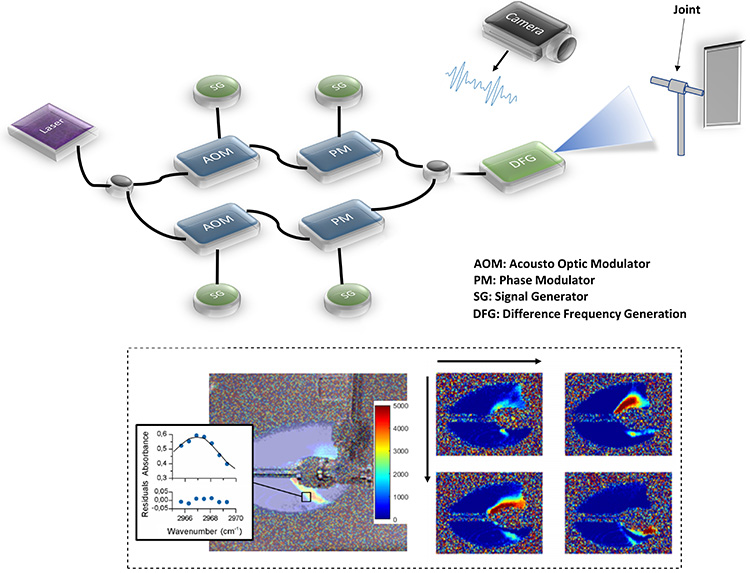 Top: Schematic of direct hyperspectral dual-comb imaging system. Bottom left: The column density of butane gas is retrieved by the hyperespectral imaging system from a single interferogram. The inset shows a sample spectrum obtained for a 10×10 pixel area. Bottom right: The system is fast enough to enable consecutive direct dual-comb hyperspectral images to be acquired a 1-s intervals, showing the leak’s temporal evolution.
Top: Schematic of direct hyperspectral dual-comb imaging system. Bottom left: The column density of butane gas is retrieved by the hyperespectral imaging system from a single interferogram. The inset shows a sample spectrum obtained for a 10×10 pixel area. Bottom right: The system is fast enough to enable consecutive direct dual-comb hyperspectral images to be acquired a 1-s intervals, showing the leak’s temporal evolution.
Hyperspectral imaging provides spectral information for each image pixel, revealing in-depth information about the object or substance under study. Use of the technique has increased in many different applications in medicine, industry, environment and other areas. Moreover, merging current hyperspectral-imaging systems with dual-comb spectroscopy can significantly enhance their performance,1 potentially opening new applications.
Until recently, the speed of dual-comb hyperspectral-imaging systems has been hindered by the required mechanical raster scan. The first scanless dual-comb hyperspectral-imaging system, demonstrated in 2017, removed the need for mechanical parts but failed to improve acquisition speed.2 Early last year, we presented the first direct hyperspectral dual-comb imaging system, which is based on generating low-rate (1 s) interferograms that can be directly detected by a video camera in the near-infrared region,3 transforming a regular camera into a high-performance hyperspectral imager.
In our recent work, to take full advantage of our system for gas imaging applications, we shifted the operating range from the near-infrared to the mid-infrared.4 Most current passive optical gas imagers use a narrow optical bandpass filter on the detector to let only the desired signal through. Thus accurate gas identification is unfeasible if multiple gas absorption lines coincide with the filter’s spectral range. The dual-comb approach substantially improved on the performance of earlier imagers, providing what we believe is an unprecedented combination of superfine spectral and high temporal resolution, and also removing the need of thermal contrast between target gas and background.
To validate the system, we analyzed a butane gas leak and extracted the absorption lines from each pixel of the scene, providing a hyperspectral image. The system was able to characterize the leak’s evolution with a temporal resolution of just 1 s,4 with substantial potential for future improvement. The system also provides a freely selectable spectral resolution and thus can be adjusted according to the application.
Our system provides a high level of sensitivity and selectivity, and simultaneously can acquire spectral and spatial information in short acquisition times, enabling the analysis of dynamic samples. One advantage of the method is that it can be implemented in different spectral regions, such as the millimeter-wave and terahertz ranges, where a growing number of interesting applications are emerging, ranging from the food industry to waste management and quality control in pharmaceuticals.
Researchers
Farid Ullah Khan and Pedro Martín Mateos, Universidad Carlos III de Madrid, Leganés, Spain
References
1. I. Coddington et al. Optica 3, 414 (2016).
2. K. Shibuya et al. Opt. Express 25, 21947 (2017).
3. P. Martín-Mateos et al. Optica 7, 199 (2020).
4. F.U. Khan et al. Opt. Lett. 45, 5335 (2020).

